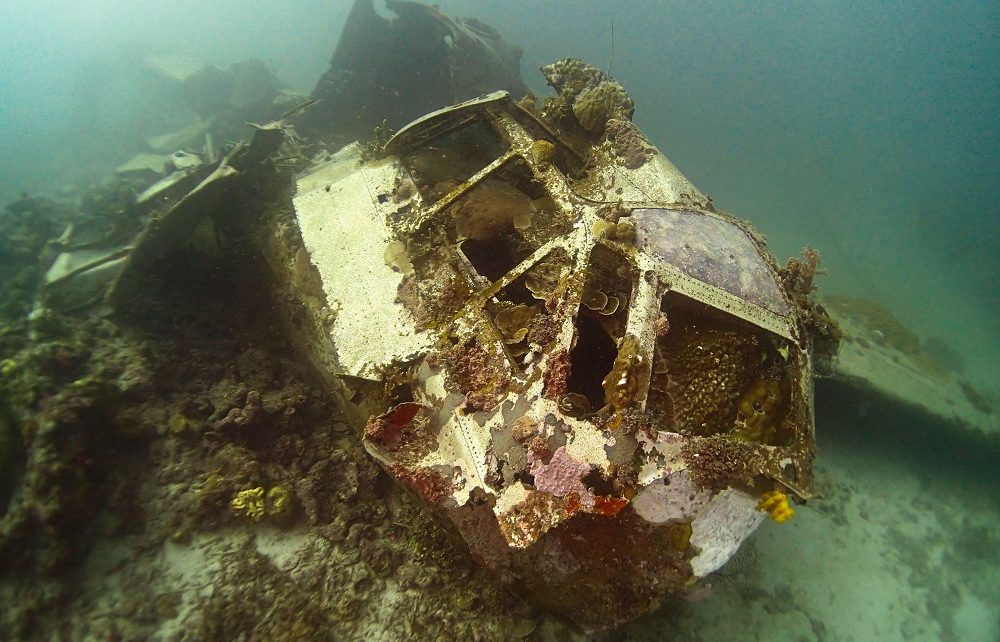The Betty Bomber plunged out of control, engines failing, and hit the waters of Chuuk Lagoon. The aircraft crashed into the waves a few hundred metres short of Eten Island airstrip. The engines broke off, finally coming to rest some distance from the plane. The coral encrusted cockpit now lies detached from the body in a twisted mess of aluminium. The wings and main fuselage are still largely intact. Nearby, shoals of bluestripe snapper patrol the selection of artefacts that lie scattered on the seabed. Whether this Mitsubishi G4M was shot down or was simply the victim of an unfortunate accident remains a mystery.
Gun Turrets On The Betty Bomber
As soon as we entered the water we could see the Betty Bomber laid out on the sand below. Dropping down the line, we recognised the gun turrets and observation blisters that gave the crew a clear view in all directions.
These long range aircraft were built for performance and their lack of armour made them light and efficient. It also made them vulnerable so they could be shot down easily.

Starboard Wing
We cruised under the wings, which are now covered in colourful soft corals and sponges. The fuel tanks for the Betty Bombers were integrated into the wings. When hit by the enemy, these unprotected fuel tanks often caught fire or exploded. This led to nicknames like the Flying Cigar or Flying Zippo. Thankfully this Betty Bomber didn't explode and the wings are still intact.

Inside The Betty Bomber
Entering the fuselage behind the cockpit we found metal shelving with an assortment of mess tins and other small items. We then swam down the centre of the plane, which was largely empty. Having looked around, we took the easy route out through one of the large observation blisters.

The Pilot's Seat
We explored the area around the Betty Bomber and found various artefacts strewn on the sand. The pilot's seat and the remains of a radio were easily identifiable.

Betty Bomber's Engine
Swimming off into the blue, we came across both engines around 60 metres from the rest of the wreck. From a distance they looked like coral bommies with propellers but up close we could see more detail. Although no one knows why the Betty Bomber crashed, the straight propeller blades show the engines had stopped prior to impact.

Betty Bomber Diving Tips
The Betty Bomber is a shallow dive. We reached a maximum depth of 20 metres. It makes a good final dive of the day after some of the deeper wrecks in Chuuk Lagoon.
The inside of the Betty Bomber is worth exploring. It is possible to swim right through and squeeze out through a tiny gap at the tail. Unless your buoyancy control is spot on, you are likely to kick up a lot of silt doing this. It may be easier to come out one of the observation blisters near the wings.
The engines lie on the sand around 60 metres away from the Betty Bomber. From the front of the aircraft, we swam on a bearing of 110° to find the engines.
Taking a break from diving? Find out what to do on Weno island.
How To Get To Chuuk Lagoon
Flights to Chuuk are very limited and only operate around 3 times a week.
1. Fly to Tokyo, Osaka, Seoul or Manila.
2. Take a United Airlines flight to Guam and from there on to Chuuk.
Many thanks to the Odyssey liveaboard for their kind hospitality. The level of service on board was exceptional and the rooms were larger than the average hotel room. Captain Mike's in-depth knowledge of the wrecks and his detailed videos made the dive briefings really special too.

Great article and photos. I dived from the S. S. Thorfinn to many of the Truk lagoon wrecks including the Betty Bomber in 1960. It was a family trip with three of my brothers and a few friends. Unfortunately on our last Dive my brother Robbie came out of the water unable to walk apparently paralyzed from the waste down. We rushed him to the decompresion chamber in Truck which did no help then finally to another in Hawaii. He remained paralyzed from the waste down for many years but still able to function with the help of special equipment. He past away a year ago. At 82 I am now writing the story of my life including the truk lagoon dive. I have written two Historical novels “Beyond the Bitter Sea” and “Beyond the Gates of Ani” Thanks for your help.
That’s very sad to hear about your brother. We’ll check out your books.